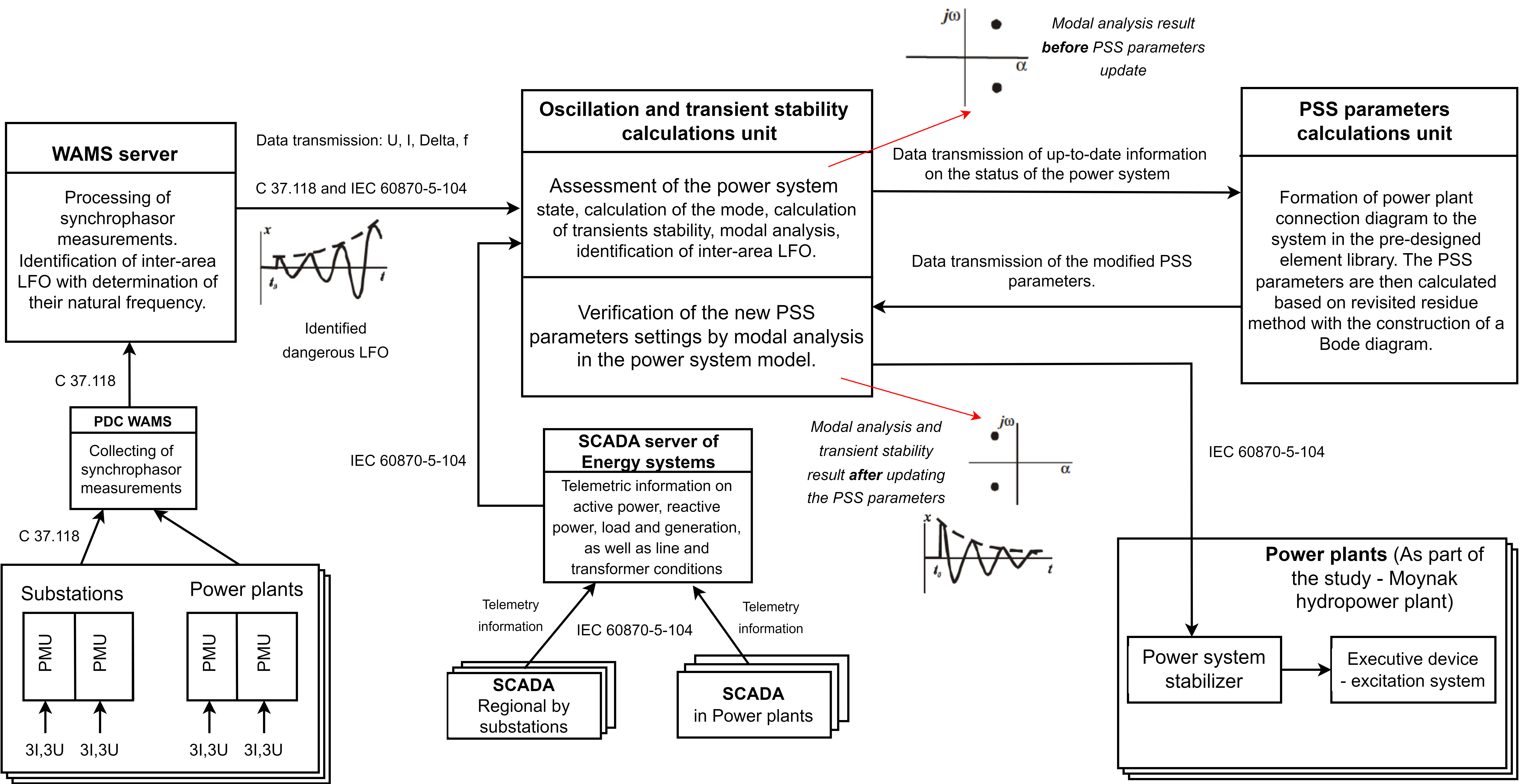Ідентифікація та згасання низькочастотних коливань на основі даних WAMS та переглянутого методу залишків – частина I
DOI:
https://doi.org/10.15587/1729-4061.2023.275088Ключові слова:
ідентифікація коливань, WAMS, стабілізатор енергосистеми, демпфування, метод залишківАнотація
Наведено результати ідентифікації низькочастотних коливань в електромережі Республіки Казахстан за допомогою широкозонної вимірювальної системи та запропоновано алгоритм демпфування низькочастотних коливань. Аналіз слабко затухаючих міжзональних низькочастотних коливань виявив сталу моду з діапазоном частот 0,3–0,4 Гц. Визначено, що при цих низькочастотних коливаннях амплітуда коливань активної потужності вздовж ЛЕП становила 150 МВт тривалістю 9 хвилин. Розрахунок модального аналізу моделі енергосистеми Республіки Казахстан у програмному забезпеченні «DigSilent Power Factory» показує небезпечні низькочастотні режими коливань з коефіцієнтом загасання 2,2 % і власною частотою 0,328 Гц. Ці режими коливань, ідентифіковані за реальними даними та в розробленій моделі, свідчать про некоректне налаштування параметрів стабілізатора енергосистеми на електростанціях. Необхідно перенастроювати параметри стабілізатора енергосистеми при кожній зміні конфігурації системи та режиму.
Проведено аналіз існуючих методів налаштування стабілізатора енергосистеми та визнано достатньо ефективним повторно розглянутий метод залишку. Таким чином, розроблений алгоритм ідентифікації та демпфування низькочастотних коливань складається з трьох задач. Першим завданням є збір даних із системи глобального вимірювання та системи диспетчерського контролю та збору даних та оновлення розрахункової моделі на основі поточного стану обладнання (генератори, трансформатори, лінії електропередачі тощо). Друге завдання – ідентифікація небезпечних електромеханічних коливань і модальний аналіз на основі інформації, отриманої в реальному часі. Третє завдання – налаштування параметрів стабілізатора енергосистеми для демпфування небезпечних низькочастотних режимів коливань на основі методу переглянутого залишку
Посилання
- Kundur, P., Malik, O. P. (2022). Power System Stability and Control. McGraw-Hill. Available at: https://www.accessengineeringlibrary.com/content/book/9781260473544
- Gupta, D. P. S., Sen, I. (1993). Low frequency oscillations in power systems: A physical account and adaptive stabilizers. Sadhana, 18 (5), 843–868. doi: https://doi.org/10.1007/bf03024228
- Hatziargyriou, N., Milanovic, J., Rahmann, C., Ajjarapu, V., Canizares, C., Erlich, I. et al. (2021). Definition and Classification of Power System Stability – Revisited & Extended. IEEE Transactions on Power Systems, 36 (4), 3271–3281. doi: https://doi.org/10.1109/tpwrs.2020.3041774
- Gonzalez-Longatt, F., Rueda Torres, J. L. (Eds.) (2018). Advanced Smart Grid Functionalities Based on PowerFactory. Green Energy and Technology. doi: https://doi.org/10.1007/978-3-319-50532-9
- Tokhtibakiev, K., Saukhimov, A., Bektimirov, A., Merekenov, M., Shubekova, K., Murat, A. (2017). Control of steady-state stability of 500 kV transmission lines in the National Electrical Networks of Kazakhstan using PMUs data. 2017 52nd International Universities Power Engineering Conference (UPEC). doi: https://doi.org/10.1109/upec.2017.8231859
- Zhang, X., Lu, C., Liu, S., Wang, X. (2016). A review on wide-area damping control to restrain inter-area low frequency oscillation for large-scale power systems with increasing renewable generation. Renewable and Sustainable Energy Reviews, 57, 45–58. doi: https://doi.org/10.1016/j.rser.2015.12.167
- Zolotas, A. C., Chaudhuri, B., Jaimoukha, I. M., Korba, P. (2007). A Study on LQG/LTR Control for Damping Inter-Area Oscillations in Power Systems. IEEE Transactions on Control Systems Technology, 15 (1), 151–160. doi: https://doi.org/10.1109/tcst.2006.883232
- Zhao, J., Zhang, Y., Zhang, P., Jin, X., Fu, C. (2016). Development of a WAMS based test platform for power system real time transient stability detection and control. Protection and Control of Modern Power Systems, 1 (1). doi: https://doi.org/10.1186/s41601-016-0013-1
- Karavas, C.-S. G., Plakas, K. A., Krommydas, K. F., Kurashvili, A. S., Dikaiakos, C. N., Papaioannou, G. P. (2021). A Review of Wide-Area Monitoring and Damping Control Systems in Europe. 2021 IEEE Madrid PowerTech. doi: https://doi.org/10.1109/powertech46648.2021.9495037
- Sallam, A. A., Malik, O. P. (2015). Power system stabiliser. Power System Stability: Modelling, Analysis and Control, 277–310. doi: https://doi.org/10.1049/pbpo076e_ch11
- Prasertwong, K., Mithulananthan, N., Thakur, D. (2010). Understanding Low-Frequency Oscillation in Power Systems. The International Journal of Electrical Engineering & Education, 47 (3), 248–262. doi: https://doi.org/10.7227/ijeee.47.3.2
- Klein, M., Rogers, G. J., Kundur, P. (1991). A fundamental study of inter-area oscillations in power systems. IEEE Transactions on Power Systems, 6 (3), 914–921. doi: https://doi.org/10.1109/59.119229
- Technical background and recommendations for defence plans in the Continental Europe synchronous area (2010). Available at: https://eepublicdownloads.entsoe.eu/clean-documents/pre2015/publications/entsoe/RG_SOC_CE/RG_CE_ENTSO-E_Defence_Plan_final_2011_public.pdf
- Schleif, F., White, J. (1966). Damping for the Northwest - Southwest Tieline Oscillations - An Analog Study. IEEE Transactions on Power Apparatus and Systems, PAS-85 (12), 1239–1247. doi: https://doi.org/10.1109/tpas.1966.291642
- Ashton, P. (2014). Exploiting Phasor Measurement Units for Enhanced Transmission Network Operation and Control. doi: https://doi.org/10.13140/RG.2.2.20151.62883
- Hsu, Y.-Y., Shyue, S.-W., Su, C.-C. (1987). Low Frequency Oscillations in Longitudinal Power Systems: Experience with Dynamic Stability of Taiwan Power System. IEEE Transactions on Power Systems, 2 (1), 92–98. doi: https://doi.org/10.1109/tpwrs.1987.4335079
- Venkatasubramanian, V. (M.), Li, Y. (2004). Analysis of 1996 Western American Electric Blackouts. Bulk Power System Dynamics and Control - VI, 685–721. Available at: https://www.academia.edu/9198860/Analysis_of_1996_Western_American_Electric_Blackouts
- Phadke, A. G., Volskis, H., de Moraes, R. M., Bi, T., Nayak, R. N., Sehgal, Y. K. et al. (2008). The Wide World of Wide-area Measurement. IEEE Power and Energy Magazine, 6 (5), 52–65. doi: https://doi.org/10.1109/mpe.2008.927476
- Xie, X., Xin, Y., Xiao, J., Wu, J., Han, Y. (2006). WAMS applications in Chinese power systems. IEEE Power and Energy Magazine, 4 (1), 54–63. doi: https://doi.org/10.1109/mpae.2006.1578532
- Anderson, P. M., Fouad, A. A. (2002). Power System Control and Stability. Wiley-IEEE Press. doi: https://doi.org/10.1109/9780470545577
- Gataric, S., Garrigan, N. R. (1999). Modeling and design of three-phase systems using complex transfer functions. 30th Annual IEEE Power Electronics Specialists Conference. Record. (Cat. No.99CH36321). doi: https://doi.org/10.1109/pesc.1999.785584
- Temgenevskaya, T. V. (2017). Methods of setting automatic excitation regulators of synchronous generators. Modern Technologies. System Analysis. Modeling, 3 (55). doi: https://doi.org/10.26731/1813-9108.2017.3(55).84-94
- Labdelaoui, H., Boudjema, F., Boukhetala, D. (2016). A multiobjective tuning approach of power system stabilizers using particle swarm optimization. Turkish Journal of Electrical Engineering & Computer Sciences, 24, 3898–3909. doi: https://doi.org/10.3906/elk-1411-200
- Rodrigues, F., Molina, Y., Silva, C., Ñaupari, Z. (2021). Simultaneous tuning of the AVR and PSS parameters using particle swarm optimization with oscillating exponential decay. International Journal of Electrical Power & Energy Systems, 133, 107215. doi: https://doi.org/10.1016/j.ijepes.2021.107215
- Kennedy, J., Eberhart, R. (1995). Particle swarm optimization. Proceedings of ICNN’95 - International Conference on Neural Networks. doi: https://doi.org/10.1109/icnn.1995.488968
- Sedghi, M., Aliakbar-Golkar, M., Haghifam, M.-R. (2013). Distribution network expansion considering distributed generation and storage units using modified PSO algorithm. International Journal of Electrical Power & Energy Systems, 52, 221–230. doi: https://doi.org/10.1016/j.ijepes.2013.03.041
- Adepoju, G. A., Aderemi, B. A., Salimon, S. A., Alabi, O. J. (2023). Optimal Placement and Sizing of Distributed Generation for Power Loss Minimization in Distribution Network using Particle Swarm Optimization Technique. European Journal of Engineering and Technology Research, 8 (1), 19–25. doi: https://doi.org/10.24018/ejeng.2023.8.1.2886
- Cai, L. J., Erlich, I. (2005). Simultaneous Coordinated Tuning of PSS and FACTS Damping Controllers in Large Power Systems. IEEE Transactions on Power Systems, 20 (1), 294–300. doi: https://doi.org/10.1109/tpwrs.2004.841177
- Francois, D. (2015). An application of modal analysis in electric power systems to study inter-area oscillations. KTH Royal Institute of Technology, School of Electrical Engineering. Stockholm. Available at: https://www.diva-portal.org/smash/get/diva2:800004/FULLTEXT01.pdf
- Grebe, E., Kabouris, J., Lopez Barba, S., Sattinger, W., Winter, W. (2010). Low frequency oscillations in the interconnected system of Continental Europe. IEEE PES General Meeting. doi: https://doi.org/10.1109/pes.2010.5589932
- 2-2014 - IEEE Guide for Identification, Testing, and Evaluation of the Dynamic Performance of Excitation Control Systems (2014). doi: https://doi.org/10.1109/ieeestd.2014.6845300
- Marinescu, B. (2019). Residue phase optimization for power oscillations damping control revisited. Electric Power Systems Research, 168, 200–209. doi: https://doi.org/10.1016/j.epsr.2018.11.007
- Oscullo, J. A., Gallardo, C. F. (2020). Residue Method Evaluation for the Location of PSS with Sliding Mode Control and Fuzzy for Power Electromechanical Oscillation Damping Control. IEEE Latin America Transactions, 18 (01), 24–31. doi: https://doi.org/10.1109/tla.2020.9049458
- Merekenov, M., Tokhtibakiyev, K., Bektimirov, A., Nigmatullin, R. (2020). The advancing assessment of power system stability using smart grid technology. IOP Conference Series: Materials Science and Engineering, 994 (1), 012014. doi: https://doi.org/10.1088/1757-899x/994/1/012014
- Yazdani, L., Aghamohammadi, M. R. (2015). Damping inter-area oscillation by generation rescheduling based on wide-area measurement information. International Journal of Electrical Power & Energy Systems, 67, 138–151. doi: https://doi.org/10.1016/j.ijepes.2014.11.018
- Ranjbar, S., Aghamohammadi, M., Haghjoo, F. (2018). A new scheme of WADC for damping inter-area oscillation based on CART technique and Thevenine impedance. International Journal of Electrical Power & Energy Systems, 94, 339–353. doi: https://doi.org/10.1016/j.ijepes.2017.07.010
- Alinezhad, M. J., Radmehr, M., Ranjbar, S. (2020). Adaptive wide area damping controller for damping inter‐area oscillations considering high penetration of wind farms. International Transactions on Electrical Energy Systems, 30 (6). doi: https://doi.org/10.1002/2050-7038.12392
- Gore, R., Kande, M. (2015). Analysis of Wide Area Monitoring System architectures. 2015 IEEE International Conference on Industrial Technology (ICIT). doi: https://doi.org/10.1109/icit.2015.7125272
- Huang, T., Wu, M., Xie, L. (2018). Prioritization of PMU Location and Signal Selection for Monitoring Critical Power System Oscillations. IEEE Transactions on Power Systems, 33 (4), 3919–3929. doi: https://doi.org/10.1109/tpwrs.2017.2776103
- Chaudhuri, B., Majumder, R., Pal, B. C. (2004). Wide-Area Measurement-Based Stabilizing Control of Power System Considering Signal Transmission Delay. IEEE Transactions on Power Systems, 19 (4), 1971–1979. doi: https://doi.org/10.1109/tpwrs.2004.835669

##submission.downloads##
Опубліковано
Як цитувати
Номер
Розділ
Ліцензія
Авторське право (c) 2023 Anur Bektimirov, Om Parkash Malik, Almaz Saukhimov, Eugene Didorenko

Ця робота ліцензується відповідно до Creative Commons Attribution 4.0 International License.
Закріплення та умови передачі авторських прав (ідентифікація авторства) здійснюється у Ліцензійному договорі. Зокрема, автори залишають за собою право на авторство свого рукопису та передають журналу право першої публікації цієї роботи на умовах ліцензії Creative Commons CC BY. При цьому вони мають право укладати самостійно додаткові угоди, що стосуються неексклюзивного поширення роботи у тому вигляді, в якому вона була опублікована цим журналом, але за умови збереження посилання на першу публікацію статті в цьому журналі.
Ліцензійний договір – це документ, в якому автор гарантує, що володіє усіма авторськими правами на твір (рукопис, статтю, тощо).
Автори, підписуючи Ліцензійний договір з ПП «ТЕХНОЛОГІЧНИЙ ЦЕНТР», мають усі права на подальше використання свого твору за умови посилання на наше видання, в якому твір опублікований. Відповідно до умов Ліцензійного договору, Видавець ПП «ТЕХНОЛОГІЧНИЙ ЦЕНТР» не забирає ваші авторські права та отримує від авторів дозвіл на використання та розповсюдження публікації через світові наукові ресурси (власні електронні ресурси, наукометричні бази даних, репозитарії, бібліотеки тощо).
За відсутності підписаного Ліцензійного договору або за відсутністю вказаних в цьому договорі ідентифікаторів, що дають змогу ідентифікувати особу автора, редакція не має права працювати з рукописом.
Важливо пам’ятати, що існує і інший тип угоди між авторами та видавцями – коли авторські права передаються від авторів до видавця. В такому разі автори втрачають права власності на свій твір та не можуть його використовувати в будь-який спосіб.









